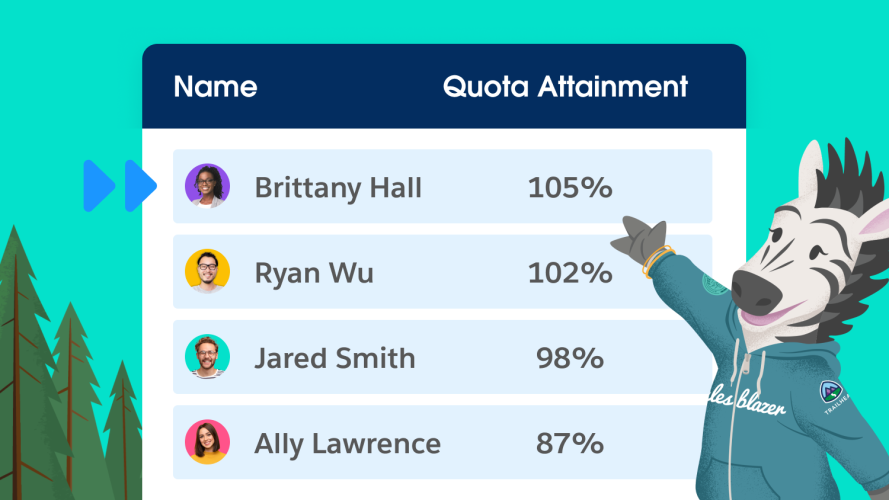5 Sales Pitch Examples (and How to Craft Your Own)

Learn more about the core elements of a good sales pitch and review sales pitch examples that do things right — and wrong.

Elyse Archer
We’ve all had to put up with pushy salespeople. I used to be one. Early in my career, I worked for a company that encouraged its salespeople to push for an immediate close, and it was soul-sucking. I’m grateful to have found a better way to sell — one that builds mutually beneficial long-term relationships.
As a sales professional, you don’t have to coerce or pressure. Instead, you need to be a curious problem solver who uses your emotional intelligence to be of service. That begins with your sales pitch.
What you’ll learn:
- What is a sales pitch?
- Why are sales pitches important?
- What are the core elements of a sales pitch?
- What are the types of sales pitches?
- What are the do’s and don’ts of sales pitches?
- What are some sales pitch examples based on different scenarios?
- How do you craft your own sales pitch?
Drive pipe faster with a single source of truth
Discover how Sales Cloud uses data and AI to help you manage your pipeline, build relationships, and close deals fast.



What is a sales pitch?
A sales pitch is a script or quick message that lets you share critical information about your product or service with a potential buyer. However, this doesn’t mean it’s all about you or your sale. A sales pitch should focus on your prospect and their needs. In other words, how your product solves their problems.
Think of your sales pitch as an invitation to take the next step, like scheduling a discovery call or setting up a demo. Each time you guide someone to the next step, the invitation will evolve with the course of your sales process. You may make several sales pitches before a final close, and each one will depend on what’s right for the prospect at each stage.
Why are sales pitches important?
They help you hook the right customers — those who would benefit most from what you have to offer. The right customer will buy what you’re selling, use it, and be better for it. Why? Because you’re not just pitching a product, you’re pitching a solution.
A strong sales pitch also gives you the opportunity to listen, ask questions that showcase your experience helping similar prospects, and share information the prospect can’t find on their own.
What are the core elements of a sales pitch?
Good sales pitches are helpful, specific, and unique. They lead prospects to a clear next step. Your energy and pitch intent are just as important as what you say, so a helpful attitude focused on your prospect’s best interest should guide you.
Successful sales pitches:
- Use a unique, personalized opening. This will help you stand out from generic pitches and show the customer you’re focused on them.
- Acknowledge your prospect’s pain points or goals. A sales pitch should always focus on your prospect and their needs first.
- Include solutions backed by data. This gives your pitch more credibility and helps to build trust with your prospect.
- Close with next steps. Set the stage for further conversation and a future relationship with your prospect.
What are the types of sales pitches?
There are many types of sales pitches, and they vary based on the steps of your sales process and channels used. You can also tailor your pitch for all types of settings, such as:
- Trade shows
- Networking events
- Sales meetings
- Over the phone
- Voicemail
- Text
- Social media
- Live or recorded videos and webinars
According to Salesforce’s State of Sales Report, 34% of deals are closed with a combination of both virtual and in-person touchpoints, while 32% are closed using only virtual channels. It’s likely that you’ll have to lean on more than one channel or pitch technique to close a deal, so it’s important to think about what these touchpoints might look like. For example, if you pitch someone in person at a trade show, you might follow up with a phone call, then an email, and so forth until you reach a close.
What are the do’s and don’ts of sales pitches?
Depending on your product and industry, your full sales cycle may cover several types of pitches before the final close. No matter which stage you’re in or what channel you’re using, here are some proven guidelines for an effective sales pitch.
- Focus on your prospect’s point of view. Don’t make it all about you. This will help you build a more authentic relationship with the client.
- Be concise. Don’t ramble. Not only will this help you come off as confident and professional, but it shows that you are knowledgeable about your product/service.
- Share who your customers are. Don’t keep secrets. Transparency is huge for building trust and credibility. If you’ve helped similar customers, share that with your client.
- Relax and ask questions. Don’t be aggressive. No one likes a pushy salesperson. Instead, try to understand their point of view and offer ways to help.
- Support your pitch with examples of success supported by visualizations. Don’t bog down presentations with words. An engaging pitch will hold your prospect’s attention and make it memorable.
- Tell a story. Don’t speak in bullet points. The more you can draw your prospect in with a story they can relate to, the more impact it will have.
- Use AI to streamline your sales pitch prep and follow-up. Don’t rely on outdated tools. Better tools will make you more efficient, help you stay organized, and keep you on track.
Sales-pitch examples for different scenarios and channels
Below are three good and two bad sales pitch examples. Many come from my own experience as a sales coach and business owner.
Good: Written note to a cold prospect
The message below could be sent via email, LinkedIn, or any other digital channel. In fact, it’s also the type of language you can use when meeting a potential customer at a networking event.
“I saw [prospect company’s] latest public update on [a project]. Based on the research we’ve compiled about [emerging customer preferences in your industry], I have an idea that could help you [solve your problem or reach a goal]. Would you like to connect to see if this could work for you? Let me know when you’re available for a 10-minute conversation so we can discuss more. In the meantime, I’d be happy to share a case study about how we [helped a similar client with a similar issue.]”
This pitch works because:
- It has a unique opening.
- It’s specific to the prospect.
- It includes a next step.
Good: Voice message sent via LinkedIn
One day, I logged into LinkedIn to see something novel in my inbox: a voice note that stood out among the written messages. I was intrigued and listened right away. Undeniably, hearing someone’s voice on a digital platform made it feel more personalized. This person used LinkedIn to their advantage intelligently; they connected with me without being pushy or going straight for the close. (You could use the script above to guide the content of your voice message.)
This pitch works because:
- It stood out on a popular channel.
- The message was personalized.
- The pitch wasn’t all about the offering.
Join the Salesblazer movement
We’re building the largest and most successful community of sales professionals, so you can learn, connect, and grow.

Good: Pre-recorded personal video
Every day, my team and I receive multiple pitches for the podcast I host. One still stands out to me after more than a year — a person who took the time to record a personal video. In it, he shared why he loved my podcast and pitched his boss as a guest. However, it wasn’t all flattery. What impressed me most was the level of research he did to customize his pitch to my show and its goals.
This pitch works because:
- It built an immediate connection.
- It was customized.
- It suggested clear next steps.
Bad: Automated, group-blasted LinkedIn message
“Hi. Did the last hire you made have you scrambling to put out fires? If the quality of your talent is lacking, we may have a solution for you. Our virtual assistants are vetted via testing and go through a rigorous assistance rotation with our managers and executives before they’re added to our roster. Take a look at our database and rates: [link].”
This pitch does not work because:
- It’s not personal.
- It relies too heavily on technology and not enough human connection.
Bad: In-person elevator pitch
“Hi, Ms. Archer. Sorry to bother you, but I wanted to share some information about the latest [version of your product offering.] We fixed issues that came to us as feedback from customers like you and added [new features.] Can we meet for lunch to discuss?”
This pitch will not work because:
- It doesn’t focus on the prospect.
- Its tone is “salesy” and superficial.
- The next step is too aggressive for an initial in-person meeting.
How to craft your own sales pitch in 5 steps
Now that you know the key components of a great sales pitch, what to avoid, and how to use different channels to your advantage, it’s time to craft your own pitch.
1. Research clients to find opportunities to help
Above all, the best pitches are service-oriented. Personally, I like to read through client testimonials to remind me of how my offering has helped clients realize big improvements. Think of success as helping prospects address pain points and achieve goals.
2. Put yourself in your prospect’s shoes
Think about your prospect (or group of segmented prospects with similar profiles). Consider what’s likely on their mind. The goal here is to think from their point of view, not yours. What would make them pause in their busy day to take notice of your offer and its benefits to them?
3. Customize your message
Your pitch should be specific and, whenever possible, customized to each prospect. You’re more likely to see success with a highly personalized pitch than with a one-size-fits-all approach that doesn’t consider your prospect’s unique needs or goals.
4. Always provide a next step
At the end of your pitch, explain what the prospect can expect. This includes a next step if they agree your pitch is a great fit for them. Depending on where your prospect is in the sales cycle, each pitch will have a different goal or next step. This might be scheduling a product demo, reference call, or closing the deal.
5. Test and refine
Each time you pitch, you’ll learn more about what works and what doesn’t. Keep track of your results so you can evolve your process and improve the experience for your customers. Pay attention to the types of pitches that bring you the most success, and lean into your unique strengths as a sales rep to pitch more effectively.
Leverage these sales pitch examples & tips to create your own
The most effective sales pitches come down to a few things: they’re service oriented, personalized, transparent, efficient, and focused on building relationships backed by credibility and trust. Whether you’re working to improve your sales pitch or just starting to test the waters, the right tools and coaching will help you automate parts of your sales process, improve your techniques, and be more productive so you can close more deals.
A new way to go from lead to close
Harness CRM data outside the CRM with Sales Engagement, and engage buyers as they move across the web.


























